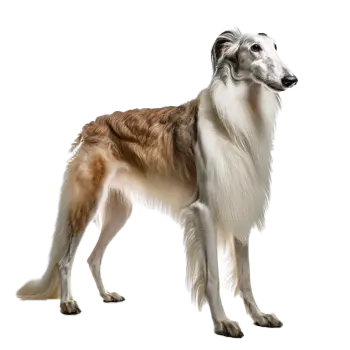Borzois are generally healthy dogs with a life expectancy of 10-12 years, typical for giant breeds. A 2024 UK study found an average life expectancy of 12 years for the breed, comparable to other large dogs though shorter than medium and small breeds. Their relatively diverse genetic background and focus on functional ability during breed development contributed to generally good health, though like all purebred dogs, Borzois face certain health concerns that potential owners and breeders should understand.
Bloat, medically known as gastric dilatation-volvulus, represents the most serious and life-threatening health concern for Borzois and all deep-chested breeds. This condition occurs when the stomach fills with gas, food, and fluid, then twists on itself, cutting off blood supply and creating a medical emergency requiring immediate surgical intervention. Symptoms include restlessness, attempts to vomit without producing anything, excessive drooling, distended abdomen, and signs of pain. Bloat develops rapidly and can kill within hours if untreated. Preventive measures include feeding multiple smaller meals rather than one large meal, preventing vigorous exercise immediately before and after eating, using slow-feed bowls, and avoiding elevated food bowls. Some veterinarians recommend prophylactic gastropexy, a surgical procedure that tacks the stomach in place and prevents twisting, which can be performed during spay or neuter surgery.
Cardiac disease affects Borzois at higher rates than many breeds. An American study examining echocardiographs of clinically healthy Borzois found that 53.8% had heart murmurs, 30.2% had trace or mild mitral regurgitation, 36.1% had mild tricuspid regurgitation, and 14.4% had diagnosable cardiac disease. These statistics emphasize the importance of cardiac screening in breeding stock and regular cardiac evaluations throughout a Borzoi's life. Many dogs with mild heart changes live normal lifespans without treatment, but monitoring allows early intervention if conditions progress.
Hip dysplasia and elbow dysplasia affect some Borzois, though less frequently than in many other large breeds. These developmental orthopedic conditions occur when joints form improperly, leading to arthritis, pain, and mobility issues. Responsible breeders screen breeding stock through Orthopedic Foundation for Animals evaluations to reduce the incidence of dysplasia in offspring. Maintaining appropriate body weight and providing measured exercise during growth helps minimize impact in dogs predisposed to these conditions.
Osteochondritis dissecans, another orthopedic condition, involves abnormal cartilage development in joints, most commonly affecting the shoulder. Affected dogs typically show lameness between 5-7 months of age. Treatment may involve rest, anti-inflammatory medication, or surgery depending on severity. Proper nutrition during puppyhood, avoiding over-supplementation and maintaining moderate growth rates, helps reduce the risk of developmental orthopedic problems.
Degenerative myelopathy, a progressive disease of the spinal cord, can affect older Borzois. This condition causes gradual loss of coordination in the hindquarters, progressing to paralysis over time. No cure exists, though supportive care including physical therapy and mobility aids can maintain quality of life for a period. Genetic testing identifies carriers of the gene mutation associated with degenerative myelopathy.
Borzois, like all sighthounds, demonstrate unusual sensitivity to anesthesia and sedatives due to their low body fat percentage and lean muscle mass. These characteristics alter drug metabolism, causing slower recovery from anesthesia compared to other breeds. This doesn't mean Borzois should avoid necessary procedures requiring anesthesia, but veterinarians must adjust dosages and monitor recovery carefully. Borzoi owners should inform veterinary staff of their dog's breed and sensitivity before any procedure requiring anesthesia or heavy sedation.
Preventive care significantly impacts Borzoi health and longevity. Regular veterinary examinations, ideally annually for young adults and twice yearly for seniors over seven years, allow early detection of developing problems. Cardiac evaluations become particularly important given the breed's predisposition to heart conditions. Maintaining appropriate body weight through proper nutrition reduces stress on joints and organs. High-quality dog food formulated for large or giant breeds provides necessary nutrients. Bloat prevention strategies should be implemented from puppyhood. Regular screening for breed-specific health concerns through hip and elbow evaluations, cardiac examinations, thyroid testing, and appropriate genetic testing enables early intervention when problems arise, potentially extending both lifespan and quality of life.
Common Health Issues
- Hip dysplasia and elbow dysplasia affect some Borzois, though less frequently than in many other large breeds.
Preventive Care & Health Monitoring
- Preventive measures include feeding multiple smaller meals rather than one large meal, preventing vigorous exercise immediately before and after eating, using slow-feed bowls, and avoiding elevated food bowls.
- These statistics emphasize the importance of cardiac screening in breeding stock and regular cardiac evaluations throughout a Borzoi's life.
- Maintaining appropriate body weight and providing measured exercise during growth helps minimize impact in dogs predisposed to these conditions.
- Preventive care significantly impacts Borzoi health and longevity.
Regular veterinary check-ups and preventive care are essential for maintaining your Borzoi's health and longevity.

